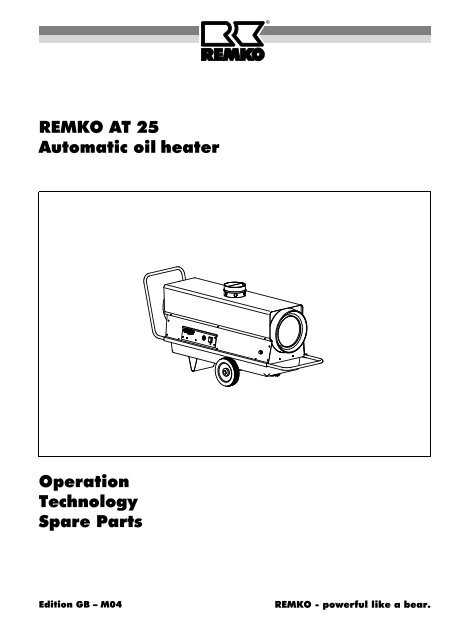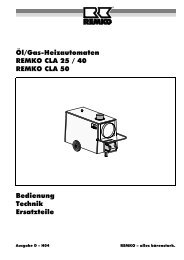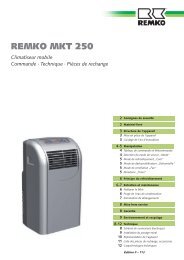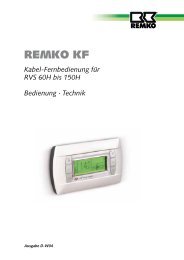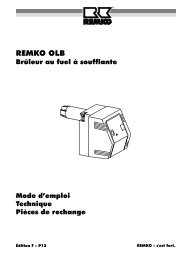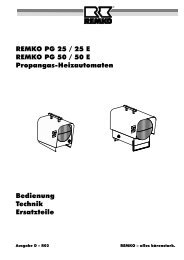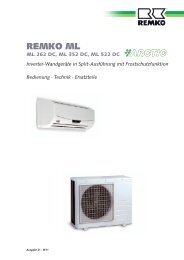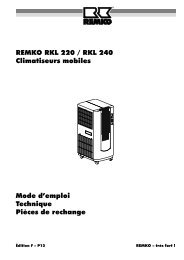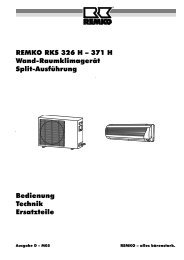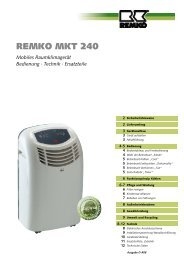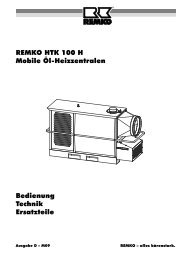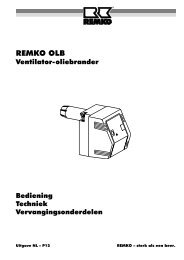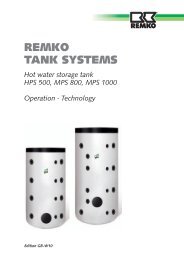remko at25
remko at25
remko at25
You also want an ePaper? Increase the reach of your titles
YUMPU automatically turns print PDFs into web optimized ePapers that Google loves.
REMKO AT 25<br />
Automatic oil heater<br />
Operation<br />
Technology<br />
Spare Parts<br />
Edition GB – M04<br />
REMKO - powerful like a bear.
Make sure to read these instructions carefully before starting/using the unit!<br />
Our guarantee will become void when the unit supplied by us is used and<br />
Contents Page<br />
Safety Instructions 4<br />
Description of device 4<br />
Provision of air heaters 5<br />
Installation instructions 6<br />
Exhaust system 6<br />
Starting 7<br />
Unit shut down 7<br />
Maintenance and service 8<br />
Burner adjustment 8<br />
� Always<br />
Operating Instructions<br />
installed for inadequate purposes, or maintained incorrectly, etc.,<br />
or if it is changed without our prior consent.<br />
Subject to alterations!<br />
Automatic oil heater<br />
REMKO AT 25<br />
Contents Page<br />
Exhaust measurement 9<br />
Service and Guarantee 9<br />
Fuel pump 10<br />
Technical data 10<br />
Wiring diagram 10<br />
Troubleshooting 11<br />
Exploded view 12<br />
Spare part list 13<br />
Maintenance log 14<br />
keep these operating instructions near or on the unit! �<br />
3
Safety Instructions<br />
Please make sure that the relevant local building<br />
and fire protection codes as well as the regulations<br />
of the employer's liability insurance associations<br />
are observed when the units are used.<br />
◊ The units may be operated only by persons who<br />
have been trained in this field.<br />
◊ The unit is to be installed and operated in such a<br />
way as to ensure that the employees are not endangered<br />
by waste gases and radiation heat and that no<br />
fire can break out.<br />
◊ The unit may only be installed and operated in<br />
rooms, when the air-rate fed to the unit is sufficient<br />
for combustion.<br />
◊ Without an exhaust system, the unit may only be operated<br />
in well aerated rooms. The permanent stay of<br />
persons in the room where the units are installed is<br />
prohibited.<br />
Appropriate prohibition signs are to be fitted at the<br />
entrances.<br />
◊ Mobile fuel reservoirs may be installed only when the<br />
technical rules for combustible liquids are observed.<br />
◊ The unit is to be installed only on a non-combustible<br />
ground.<br />
◊ The unit may not be installed and operated in inflammable<br />
and explosive surroundings.<br />
◊ A safety zone of 1.5 m around the unit, as well as a<br />
minimum distance of 3 m from the unit's blower aperture<br />
is to be maintained, even in the case of non<br />
combustible objects.<br />
◊ The blower aperture of the unit may not be narrowed<br />
or equipped with hoses and conduits.<br />
◊ The protective air suction grille is always to be kept<br />
free from dirt and loose objects.<br />
◊ Make sure not to introduce foreign matters into the<br />
unit.<br />
◊ Make sure not to expose the unit to direct water jets.<br />
◊ All electric cables outside the unit are to be protected<br />
from damage (e.g. caused by animals, etc.).<br />
◊ Make sure always to pull the mains plug out of the<br />
mains socket when maintenance and repairs are<br />
carried out.<br />
�<br />
�<br />
4<br />
During the unit’s operation, safety devices may<br />
neither be bridged nor blocked!<br />
On account of the construction type, a fixedlocation<br />
device installation is not permissible!<br />
Description of Device<br />
The unit is fired directly with heating oil EL or diesel and<br />
can be operated with or without an exhaust-gas connection.<br />
It is intended for mobile and fully automatic deployment.<br />
A fuel container is built under the unit and it is equipped<br />
with automatic tank heating, a high-pressure atomizing<br />
oil burner with optical flame monitoring, a low maintenance<br />
axial ventilator, a connection cable with plug, a<br />
room thermostat socket and a fivefold filter system.<br />
The unit complies with the basic safety and health requirements<br />
of the relevant EU stipulations and is reliable<br />
and simple to operate.<br />
The unit can be used e.g. in the following areas:<br />
- for drying new buildings;<br />
- for point heating of outdoor workplaces;<br />
- for point heating of workplaces in open, non firehazard<br />
fabrication rooms and halls;<br />
- for temporary heating of closed and open areas;<br />
- for de-icing of machines, vehicles and non flammable<br />
storage goods;<br />
- for tempering frost-endangered parts.<br />
Working of Device<br />
The automatic tank heating is activated by connecting<br />
the mains plug with a mains socket.<br />
When the unit has been switched on or when heat is required<br />
(automatic function with room thermostat) the<br />
supply air fan starts. The fan blows air into and along<br />
the combustion chamber.<br />
When the preliminary ventilation is over, the electromagnetic<br />
valve opens and supplies fuel to the nozzle.<br />
The fuel, sprayed under high pressure, is enriched by<br />
an adequate quantity of oxygen according to the heating<br />
capacity and ignited by an electric spark.<br />
Ignition is automatically terminated as soon as a perfect<br />
flame burns and the flames are controlled by the automatic<br />
burner relay. After a few seconds hot air is blown<br />
out.<br />
In case of any troubles, or if the flame is unstable or<br />
tends to go out, the unit is switched off by the automatic<br />
burner relay. The fault indicator warning lamp of the<br />
automatic burner relay lights up. A restart cannot be<br />
made before the manual release of the automatic<br />
burner relay.<br />
When the unit has been switched off via the operating<br />
switch or the room thermostat, the supply air fan continues<br />
running for some time to cool down the combustion<br />
chamber and then it stops automatically.<br />
Depending on the required heat rate the function described<br />
above is repeated automatically in the case of<br />
an operation with thermostat.<br />
For optimum unit operation, the device should not<br />
� be operated at an ambient temperature above 25 °C.
Safety temperature limiter (STB)<br />
The safety temperature limiter (STB) interrupts the<br />
burner operation in the event of overheating and locks<br />
all unit functions.<br />
If the safety temperature limiter has triggered, the cause<br />
of the disturbance must first be localised and eliminated.<br />
Resetting via the "RESET" key is only possible<br />
after the sensor has cooled to below ca. 90 °C.<br />
The safety temperature limiter is unlocked by pressing<br />
the reset key.<br />
1<br />
2<br />
1. Detach the protection cap 1.<br />
2. Press the reset key 2.<br />
3. Replace the protection cap.<br />
Provision for Air Heaters<br />
For the deployment of the unit, the relevant guidelines<br />
must be observed<br />
1. Operating personnel<br />
1.1 The unit must only be operated by persons who<br />
have been trained in its operation.<br />
2. Installation<br />
2.1 The unit must be installed so that it can stand in a<br />
stable position.<br />
2.2 The unit must be installed and operated in such a<br />
way that the employees are not exposed to the<br />
danger of exhaust gases and radiant heat and that<br />
the occurrence of fires is ruled out.<br />
2.3 The unit may only be installed and operated in<br />
rooms if a quantity of air sufficient for the combustion<br />
is supplied to the unit and the exhaust gases<br />
are removed to the exterior.<br />
A natural air supply sufficient for the combustion is<br />
present if e.g.<br />
The room contents in m² correspond with at least<br />
10 times the nominal heat load in kW of all the<br />
units operating in the room and if windows and<br />
doors ensure a natural change of air.<br />
2.4 In deviation from point 2.3, the unit can be operated<br />
without an exhaust system in rooms if these<br />
rooms have a sufficient air supply and are well ventilated<br />
and if materials harmful to health do not<br />
reach an unhealthy concentration.<br />
2.5 A good natural air supply and ventilation is the case<br />
if e. g.<br />
The room contents in m² correspond with at least<br />
30 times the nominal heat output of all units operating<br />
in the room and a natural change of air is ensured<br />
through windows and doors, or<br />
openings which are not lockable are present in the<br />
region of ceiling and floor for the air supply and for<br />
out going air and the size of these openings in m²<br />
corresponds with at least 0.003 times the nominal<br />
heat output in kW of all units operating in the room.<br />
2.6 The unit must not be installed or operated in rooms<br />
and areas where the danger of fire or explosion exists.<br />
3. Room drying<br />
3.1 In deviation from point 2.3, in order to dry rooms<br />
with an air supply sufficient for the combustion,<br />
heating units can be operated without the exhaust<br />
gases being removed to the exterior. In these<br />
rooms, the permanent presence of persons is forbidden.<br />
Signs on the entrances to the rooms must<br />
indicate that this is forbidden.<br />
4. Examination<br />
4.1 The unit must be tested by an expert as to its work<br />
safety specific condition in accordance with the required<br />
deployment conditions but at least once annually.<br />
4.2 The exhaust values of the burner must be checked.<br />
5. Monitoring<br />
5.1 When starting work, the persons commissioned<br />
with the operation of the unit must check the unit<br />
for obvious defects or deficiencies on the operational<br />
and safety mechanisms and check that the<br />
safety mechanisms are present.<br />
5.2 If defects or deficiencies are discovered, the supervisor<br />
must be informed.<br />
5.3 In the case of defects or deficiencies which en danger<br />
the operational safety of the unit, its operation<br />
must be terminated.<br />
6. Installation in closed, well aerated rooms without<br />
connection to a chimney<br />
6.1 The operation of the units is admissible when the<br />
minimum air quantity needed for combustion and<br />
mentioned in point 2.5 is supplied.<br />
6.2 A safe exhaustion of the waste gases is to be ensured<br />
to exclude inadmissible pollution.<br />
Fresh air is fed from below;<br />
waste gases are exhausted towards the top.<br />
7. Correct usage<br />
7.1 The unit are to be used only for heating purpose in<br />
industrial or commercial application because of their<br />
construction and equipment.<br />
7.2 If specification of the manufacturer or legal regulations,<br />
are not followed or if unauthorised changes<br />
are made on the unit, the manufacturer is not liable<br />
for resulting damages.<br />
5
Installation Instructions<br />
The units are generally to be operated in accordance<br />
with the safety rules, the building code of the land concerned<br />
and the fire protection code.<br />
◊ Avoid under or overpressure in the room where the<br />
unit is installed, as this would result in combustion<br />
troubles.<br />
◊ Suction and blow-out cross sections may not be reduced<br />
◊ It is prohibited to connect conduits or hoses to the<br />
unit blow-out opening.<br />
◊ Make sure that the technical regulations for combustible<br />
liquids are observed when mobile fuel holders<br />
are installed.<br />
Outside Installation<br />
◊ The units are to be installed outside and to be protected<br />
from atmospheric effects to avoid damage.<br />
◊ Make sure that no danger or inadmissible annoyance<br />
is caused by the operation of the unit.<br />
Room Heating<br />
◊ For room heating, hot air generators may only be operated<br />
with a room thermostat (accessories).<br />
◊ Make sure that sufficient fresh air is fed to ensure<br />
perfect combustion. Fresh air is to be fed preferably<br />
through windows and doors or through sufficiently dimensioned<br />
openings in the outer wall.<br />
Safety Distances<br />
◊ Make sure to observe the following safety distances<br />
to ensure a safe operation of the unit:<br />
– towards the top, fire-retarding ceiling 1,5 m<br />
6<br />
– towards the sides, non-burning objects 0,6 m<br />
– blow-off side, with non-burning objects 3,0 m<br />
– suction side, for perfect air supply 1,0 m<br />
◊ The floor and the ceiling must be from fire-retarding<br />
materials.<br />
Electric Connection<br />
◊ The unit are operated with 230 V alternating current.<br />
◊ Electric connection is carried out via a fitted mains<br />
cable with shockproof plug.<br />
◊ Possibly required extension cables must be selected<br />
according to the existing cable length, the unit’s connecting<br />
line and the intended purpose.<br />
All extension cables are to be used only after<br />
� having been removed from the roller.<br />
�<br />
The electric connection of the unit is to be carried<br />
out via a special supply point with fault current<br />
safety switch.<br />
Exhaust system<br />
In the outdoors or in open rooms, the operation of the<br />
device is also possible without an exhaust system.<br />
However, we recommend a 1 m exhaust-pipe (see example<br />
2) with a rain hood placed on top so as to rule out<br />
the penetration by rainwater and dirt.<br />
If the device is used for temporary room heating, the<br />
combustion gases may have to be removed to the exterior.<br />
The exhaust-pipe parts must be laid in such a way<br />
that a minimum suction of 0.1 mbar is guaranteed.<br />
�<br />
It must be made sure in all cases that counter<br />
pressure due to an incorrect exhaust system is<br />
ruled out.<br />
Malfunction-free operation is guaranteed if the exhaust<br />
system is installed in an ascending direction and with<br />
vertical end pipes.<br />
The exhaust system must terminate at least above the<br />
height of the eaves but better still above roof height in<br />
order to avoid counter pressure caused by weatherrelated<br />
circumstances (e.g. wind).<br />
All exhaust-pipe parts must be attached reliably. Their<br />
diameter must not be smaller than that of the exhaust<br />
nozzle of the device (˘ 150 mm).<br />
The minimum distance of 0.6 m to combustible parts<br />
must not be exceeded.<br />
Exhaust-pipe parts including attachment material are<br />
available as accessories.<br />
Example 1 Example 2 Example 3<br />
operating with<br />
extended<br />
waste gas pipe<br />
condensate trap<br />
necessarily<br />
Important hint.<br />
operating without<br />
extended<br />
waste gas pipe<br />
max. 1m<br />
Inadmissible<br />
arrangement.<br />
Make sure that the waste gas pipes are correctly installed<br />
with a condensate trap (see example 1), to avoid<br />
damage to the combustion chamber through humidity<br />
deposits (condensate) (see example 3).<br />
The lateral openings in the exhaust connection must not<br />
be closed or covered.
Starting<br />
Prior to starting, the unit is to be checked to make sure<br />
that there are no visible defects on the control and<br />
safety devices, that the unit has been installed correctly<br />
and that it has been properly connected to the mains.<br />
A properly trained person is to be charged with the operation<br />
and control of the unit.<br />
◊ Install unit in a stable position.<br />
◊ Make sure that combustion air is supplied.<br />
◊ Make sure that the air can be sucked in and be exhausted<br />
freely.<br />
◊ Avoid overpressure and underpressure in the room<br />
where the unit has been installed.<br />
◊ Make sure that enough fuel is supplied.<br />
◊ Fill fuel tank with clean fuel oil EL or diesel with the<br />
unit switched off.<br />
◊ Use only appropriate and clean tanks to fill with fuel.<br />
�<br />
Paraffin accumulation by low outside temperatures<br />
The supply of sufficient liquid fuel is to be ensured, even<br />
with low outside temperatures.<br />
�<br />
Fuel filter<br />
Prior to commissioning the unit and before<br />
the tank is filled each time, the main filter (F)<br />
must be checked for the presence of grime<br />
or the accumulation of paraffin.<br />
The main filter is positioning beside the filler.<br />
Make sure to fill the fuel tank only with the<br />
tank filter inserted into the filler neck.<br />
1<br />
The unit is to be installed only in well aerated<br />
rooms, but not in living rooms or similar recreation<br />
rooms!<br />
Paraffin accumulation can occur even at temperatures<br />
as low as 5 °C. Appropriate measures must<br />
be taken to avoid this.<br />
◊ The built-in tank heating is only active as long as the<br />
mains plug is connected with a functioning mains<br />
socket.<br />
◊ It is not possible to get rid of paraffin discharge<br />
which is already present using the tank heating.<br />
The requirement for this is the cleaning of the entire<br />
fuel system.<br />
Connect the unit with the current supply<br />
1. Put operating switch 1 into “0”<br />
position (OFF).<br />
2. Connect unit plug to a suitable<br />
mains socket.<br />
230V/1~ 50 Hz.<br />
F<br />
Heating without room thermostat<br />
The unit runs in continuous operation.<br />
3<br />
Heating with room thermostat (accessories)<br />
The unit runs fully automatically and depending on temperatures.<br />
5<br />
4<br />
4<br />
6<br />
1. Connect the supplied bridge circuit<br />
plug 3 to the thermostat socket 4 of<br />
the unit<br />
2. Put the operating switch into position<br />
“1” (on).<br />
1. Remove the bridge circuit plug 3.<br />
2. Connect the thermostat plug 5 of the<br />
room thermostat (accessories) into<br />
the thermostat socket 4.<br />
3. Install room thermostat 6 in a suitable<br />
place.<br />
The thermostat sensor may not be<br />
exposed directly to the hot air current<br />
and not fixed directly on a cold<br />
surface.<br />
4. Pre-select desired room temperature<br />
on the room thermostat<br />
5. Put the operating switch into position<br />
“1” (on).<br />
Unit Shut Down<br />
1. Put operating switch into position<br />
“0” (OFF).<br />
Attention, important hints to the after-cooling phase<br />
The air supply fan continues running to cool down the<br />
combustion chamber and then stops later.<br />
The fan can start several times before final switching off.<br />
�<br />
Never interrupt (except in emergency situations)<br />
the connection to the mains before the end of the<br />
whole after-cooling phase.<br />
Our guarantee does not cover damages caused<br />
to the unit by overheating.<br />
7
Maintenance and Service<br />
The unit is to be maintained regularly whereby some<br />
fundamental rules are to be observed to ensure a long<br />
service life and trouble-free operation.<br />
After each heating period or even earlier, depending on<br />
the deployment conditions, the entire unit including<br />
combustion chamber and burner head must be cleaned<br />
of soot sediments, dust and dirt.<br />
The oil filters must also be cleaned / replaced at least<br />
once a year or, depending on the degree of contamination<br />
of the fuel, frequently.<br />
�<br />
�<br />
◊ The unit is to be kept free from dust and other deposits<br />
and is to be cleaned only with a dry or humid<br />
cloth.<br />
Do not use water jet.<br />
◊ Do not use any aggressive cleaning agents or those<br />
which are harmful or environmentally unfriendly.<br />
◊ When the unit has not been used for a longer period,<br />
the fuel tank is to be emptied, rinsed and to be filled<br />
with clean fuel.<br />
◊ Use only clean fuel oil EL and diesel, respectively.<br />
Make sure to avoid paraffin formation.<br />
◊ Empty fuel tank at least twice a year and rinse it with<br />
clean fuel.<br />
Do not use water!<br />
◊ Keep burner head clean.<br />
◊ Wearing parts such as e.g. oil filters, burner nozzle<br />
and gaskets must be checked and, if necessary, replaced.<br />
In any case, we recommend the replacement of the<br />
oil jet before the start of each heating season.<br />
◊ The oil filter in the filler neck of the fuel tank is to be<br />
cleaned regularly.<br />
◊ The main oil filter is to be replaced (take care of flow<br />
direction) depending on the rate of pollution, but at<br />
least before the start of every heating period.<br />
The main filter is at the left side of the unit above the<br />
fuel tank.<br />
◊ Gauze oil filters have been installed in the fuel pump,<br />
in the magnetic valve and in the burner nozzle.<br />
These filters are to be cleaned by an expert.<br />
◊ Check safety devices regularly.<br />
◊ In the case of reducing heating capacity, formation of<br />
smoke and/or bad ignition the unit is to be inspected<br />
and the burner is to be adjusted.<br />
◊ Observe regular maintenance and care intervals.<br />
8<br />
Prior to starting any work make sure to pull the<br />
mains plug out of the mains socket!<br />
Setting and maintenance is to be carried out<br />
only by authorised personnel!<br />
Cleaning the fuel tank<br />
It is necessary to clean the fuel tank:<br />
◊ After each heating period or, depending on the<br />
deployment conditions, even earlier.<br />
◊ Before and after extended idle periods.<br />
◊ If the main filter frequently becomes dirty.<br />
◊ If condensation water accumulates in the fuel.<br />
Please proceed in the following way when cleaning the<br />
fuel tank.<br />
◊ Unscrew the discharging screw D (SW 22) and discharge<br />
the fuel into a suitable vessel.<br />
E<br />
D<br />
◊ Rinse the container several times if necessary with<br />
clean fuel thoroughly.<br />
Do not use water!.<br />
◊ Please use no cleaning agents which contain<br />
solvents.<br />
These can destroy the inner layer of the tank.<br />
◊ Avoid the use of high-pressure cleaners.<br />
◊ Fit the discharging screw D (SW 22).<br />
◊ The gasket ring E should be replaced after each<br />
disassembly.<br />
◊ Fill tank with clean fuel.<br />
◊ Start unit and let it run for approx. 3 minutes.<br />
Burner adjustment<br />
Disassembly of burner head and nozzle<br />
1. Loosen safety screw of burner head at combustion<br />
chamber.<br />
2. Loosen cap nut of fuel piping at burner head.<br />
3. Remove photo cell and ignition cable, and remove<br />
the burner head by turning from the rear wall of the<br />
burner chamber.<br />
�<br />
Use only appropriate tools to disassemble the<br />
nozzle (SW 16) and counteract at the blast connection<br />
(SW 19).
4. When maintenance has been carried out reassemble<br />
all parts carefully in reverse order.<br />
5. Pre-set air flow plate, air slide plate and the ignition<br />
electrode distance according to the approximate indications.<br />
Adjustments of the burner head<br />
air slide<br />
plate<br />
◊ Distance nozzle - air flow plate 4 mm<br />
◊ Distance nozzle - electrode tip 2 mm<br />
◊ Distance centre of nozzle - electrode tip 8 mm<br />
◊ Distance between the electrode tips 3-4 mm<br />
Coarse adjustments of the air slide plate<br />
S<br />
L<br />
1. Loosen the safety screw S.<br />
2. Set the air slide plate L by turning to an opening<br />
width of ca. 25 mm.<br />
3. Tighten the safety screw again.<br />
Fine adjustment of air slide plate<br />
Fine adjustment of air slide plate by means of CO2 indicator<br />
and soot pump.<br />
CO2 - value: approx. 10 - 13 %<br />
Soot figure: 0 - 1 (by Bacharach)<br />
2<br />
4<br />
air flow<br />
plate<br />
3-4<br />
8<br />
Exhaust Measurement<br />
On account of the construction-dependent design of the<br />
exhaust connection (connection nozzle with secondary<br />
air openings), it is not possible to perform a correct exhaust<br />
analysis in a conventional manner in the exhaust<br />
pipe behind the exhaust connection.<br />
For the performance of the exhaust analysis the sensor<br />
of the exhaust-measurement device must be placed in<br />
the centre of the pipe socket of the heat exchanger.<br />
The measurement sensor is placed through the appropriate<br />
lateral secondary air opening in the exhaust connection<br />
in the existing measurement opening in the pipe<br />
nozzle of the combustion chamber (see drawing below).<br />
Drawing top-view<br />
measurement<br />
sensor<br />
pipe socket<br />
measurement<br />
opening<br />
exhaust<br />
connection<br />
exhaust<br />
connection<br />
pipe socket<br />
measurement<br />
sensor<br />
auxiliary air<br />
opening<br />
Service and Guarantee<br />
Any claims under guarantee regarding materials can be<br />
accepted only when the orderer or his customer has<br />
filled in completely the “guarantee certificate” which is<br />
enclosed with every REMKO-heater and has returned it<br />
to REMKO GmbH & Co. KG in due time after the unit’s<br />
sale and commissioning.<br />
The units are factory tested on faultless function. If any<br />
failures occurs though which cannot be eliminated by the<br />
operating person, please contact your dealer or contact<br />
person.<br />
An operation/use other than that indicated in these instructions<br />
is prohibited!<br />
In the case of non-observation we will not be held responsible<br />
and our guarantee will become void.<br />
9
Fuel Pump<br />
The standard type of the pump runs in a system of<br />
1 pipe. The required fuel is sucked in through the suction<br />
line "S".<br />
For the first starting and after having emptied the fuel<br />
tank, the fuel system is deaerated through the burner<br />
nozzle.<br />
For this purpose the unit is switched on. After a possible<br />
switch off through failure, the unit is restarted after having<br />
released the automatic burner relay (take care of<br />
waiting time).<br />
If, after the 3rd start of the unit there is another switch<br />
off through faults, the fuel filters should be checked to<br />
make sure that they are free from pollutions and that<br />
they are tight.<br />
�<br />
�<br />
10<br />
S<br />
Perfect fuel quality is an absolute necessity for the<br />
lubrication of the pump drive.<br />
Suction of water residues should never take place<br />
and, in the case of setting, suction should not take<br />
place of warping fine dusts (e.g. cement etc.).<br />
Never let the pump run without feeding fuel for a<br />
longer period. Make sure not to leave a unit with<br />
dry run pump unattended for a longer time.<br />
Setting the pump pressure<br />
The pump pressure can only be set if a manometer is<br />
connected to the connection P. The pump pressure is<br />
changed by turning the pressure setting screw A:<br />
clockwise: increase the pressure.<br />
counter clockwise: reduce the pressure.<br />
The required pump pressure is determined according to<br />
the heating capacity (please refer to unit type plate) and<br />
to the nozzle size. The pressure setting screw "A" is to<br />
be secured with the counter nut "B" after having set the<br />
pressure.<br />
A<br />
B<br />
Filter Gasket Cover<br />
P<br />
Technical Data<br />
Model AT 25<br />
Nominal heat output max. kW 25<br />
Nominal heat output kW 22,5<br />
Air output m³/h 1020<br />
Increase of temperature Δt K 54<br />
Fuel Heating oil EL or Diesel<br />
Fuel consumption, max. kg/h 2,1<br />
Nozzle (70°W / 80°S) USG 0,6<br />
Pump pressure approx. bar 9 - 10<br />
Tank capacity Ltr. 40<br />
Electrical connection 1~ V 230<br />
Frequency Hz 50<br />
Rated current max. A 1,6<br />
Power consumption max. 1) kW 0,32<br />
Fuse protection (required) A 10<br />
Sound pressure level LpA 1m 2) dB(A) 74<br />
Exhaust connection ˘ mm 150<br />
Length mm 1250<br />
Width mm 485<br />
Height mm 685<br />
Weight kg 58<br />
1) unit inclusive tank heating<br />
2) noise measuring (when heating) DIN 45635 - 01 KL 3<br />
Wiring Diagram<br />
F = photo cell<br />
HS = auxiliary relay<br />
KL = terminal strip<br />
M = motor<br />
MV = solenoid valve<br />
NK = recool thermostat<br />
RS = relay socket<br />
S = operating switch<br />
STB = safety temperature<br />
limiter<br />
TH = thermostat socket<br />
THT = thermostat (tank heating)<br />
THZ = tank heating<br />
ZT = ignition transformer
Troubleshooting<br />
– unit does not start.<br />
– fan motor is running but burner will not be ignited.<br />
– unit shut down without flaming formation.<br />
– unit stops during operation.<br />
(fault indicator lamp of the automatic burner relay lights up)<br />
– smoke forming at the blow-out cone.<br />
– unit can’t be switched off..<br />
Trouble:<br />
2 – 3 – 4 – 6 – 7 – 8 – 25<br />
1 – 5 – 9 – 10 – 11 – 12 – 13 – 14 – 15 – 16 – 17<br />
20 – 21 – 23 – 24 – 26<br />
20<br />
4 – 5 – 6 – 7 – 8 – 9 – 10 – 11 – 13 – 15 – 16 – 17<br />
19 – 21 – 22 – 23 – 24 – 26<br />
7 – 10 – 11 – 13 – 15 – 17 – 19 – 21 – 22 – 24<br />
18 – 25<br />
Cause:<br />
The mains plug has been taken out of the mains socket before carrying out any work regarding the unit.<br />
� Setting and maintenance is to be carried out only by authorised experts! �<br />
Cause: Remedy:<br />
1. Air (bubbles) in the fuel system during starting procedure.<br />
– Press fault clearance button of the automatic burner relay,<br />
repeat if necessary (max. 3 x).<br />
2. No electrical connection. – Check mains, mains plug and current.<br />
3. No (bridge circuit-/thermostat-) plug in the thermostat socket.<br />
– Connect bridge circuit plug resp. thermostat plug with the thermostat<br />
socket.<br />
4. Thermostat setting is too low. – Set thermostat higher than the room temperature.<br />
5. Fault indicator lamp of the automatic burner relay lights up. – Unlock the automatic burner relay by pressing the reset button.<br />
6. Faults in the automatic burner relay. – Replace automatic burner relay.<br />
7. Fan motor is overcharged.<br />
(Fan blows irregularly or is blocked)<br />
– Let motor cool down.<br />
– Check slight run of fuel pump.<br />
– Check motor on electrical and mechanical function.<br />
8. Fuel pump is blocked. – Check resp. replace fuel pump.<br />
9. Fuel tank is empty. – Fill fuel tank with clean fuel.<br />
10. Fuel filter is blocked (dirty). – Clean fuel filter resp. replace if necessary.<br />
11. Nozzle is blocked resp. wrong dimension (type/size). – Replace nozzle (take care of correct type and size!).<br />
12. Wrong setting of ignition electrodes or damaged insulation. – Adjust correctly resp. replace it.<br />
13. Air flow plate of the burner head is misadjusted resp. dirty.<br />
14. Solenoid valve does not open.<br />
– Adjust correctly by means of CO2 –indicator and soot pump<br />
(CO2 : 10 – 13% and soot figure by Bacharach: 0 – 1).<br />
– Check solenoid valve resp. replace if necessary.<br />
(A „click“ should be heard during switching on/off)<br />
– The safety temperature limiter has released / is defective.<br />
15. Misadjusted pump pressure. – Set pump pressure by means of a pressure-gauge.<br />
16. Pump clutch is defective. – Replace pump clutch.<br />
17. Leakage in suction pipe or in fuel filter. – Check suction pipe and fuel filter, replace if necessary.<br />
18. Solenoid valve does not close. – Pull off the fuel pipe from the main filter - the flame dies.<br />
19. Air protecting grille is dirty. – Clean air protecting grille.<br />
20. Disconnection by the safety temperature limiter (STB).<br />
21. Air (bubbles) in the fuel system.<br />
– Check air protecting grille, clean if necessary.<br />
– Unlock safety temperature limiter (STB-Reset).<br />
22. No adequate ventilation. – Open doors or windows.<br />
– Restart the unit in order to discharge the air through the nozzle.<br />
(This procedure can be repeated up to max. 3 times).<br />
23. Photo cell is dirty resp. defective. – Clean photo cell resp. replace if necessary.<br />
24. Improper exhaust system. – See chapter “Exhaust system“.<br />
25. Operating switch not functioning. – Check operating switch resp. replace if necessary.<br />
26. Fuel with paraffin accumulation.<br />
(Already occur starting from 5 °C see notes in chapter "Starting").<br />
The tank heating is damage (very rarely).<br />
– Clean the entire fuel system.<br />
– Replace the damage tank heating.<br />
11
Exploded View<br />
12<br />
Fig. A<br />
Fig. B<br />
74<br />
See fig. B<br />
See fig. A<br />
We reserve the right to make modifications in dimensions and construction in the interests of technical progress.
Spare Part List<br />
No. Description Ref-No.<br />
1 inspection cover 1103701<br />
2 exhaust connection 1103702<br />
3 inspection cover 1103703<br />
4 gasket (inspection cover) 1103705<br />
5 combustion chamber 1103704<br />
6 blow-out connection 1103706<br />
7 housing base 1103707<br />
8 cover (filler neck) 1102925<br />
9 fuel hose (running metres) 1102156<br />
10 fuel filter 1102146<br />
11 protective socket, small 1102131<br />
12 side cover, left 1103708<br />
13 fastening screw 1102937<br />
14 cover, front / back 1103709<br />
15 side cover, right 1103710<br />
16 safety temperature limiter 1103711<br />
17 filler cap 1102148<br />
18 fuel filter (filler neck) 1102149<br />
19 hose clamp 1102157<br />
20 fuel tank cpl. (with tank heating) 1103727<br />
21 transport handle, front 1102932<br />
22 drain screw 1102152<br />
23 gasket ring (drain screw) 1102151<br />
24 wheel cap 1101623<br />
25 wheel lock ring 1101622<br />
26 wheel 1102155<br />
27 transport handle, back 1102931<br />
28 connecting cable with plug 1101320<br />
29 automatic burner relay 1102239<br />
30 PG-plate 1102533<br />
31 locking screw (PG-plate) 1103716<br />
32 relay socket 1102534<br />
33 protective socket 1101528<br />
34 operating switch 1102248<br />
35 cover 1103713<br />
36 mounting plate 1103714<br />
37 auxiliary relay 1102137<br />
38 terminal strip 12 x 1103715<br />
39 ignition cable, kit 1102159<br />
40 ignition electrode 1102132<br />
41 traction relief 1108325<br />
No. Description Ref-No.<br />
42 thermostat socket 1101018<br />
43 bridge circuit plug 1101019<br />
44 protective socket, big 1101615<br />
45 capacitor 1102907<br />
46 connection cable (solenoid valve) 1102825<br />
47 hose connection fitting 1102109<br />
48 fuel pump (with solenoid valve) 1103717<br />
49 copper pipe 4 mm, cpl. 1102315<br />
50 angle clutch 1/8“ x 4 1102112<br />
51 solenoid valve 1103718<br />
52 pump clutch 1102936<br />
53 fan motor 1102905<br />
54 fan housing 1103719<br />
55 photo cell holder 1102126<br />
56 photo cell 1108209<br />
57 fan blade 1103720<br />
58 protecting grille 1103721<br />
59 clamp (ignition electrode) 1102120<br />
60 ignition electrode 1102118<br />
61 protection hose 1101617<br />
62 angle clutch 1102116<br />
63 cutting ring 4 mm 1102908<br />
64 sleeve nut 4 mm 1102909<br />
65 connection pipe 1102117<br />
66 air slide plate 1103722<br />
67 holder (nozzle) 1102121<br />
68 nozzle 1102923<br />
69 air flow plate 1102122<br />
70 burner head 1103723<br />
71 recool thermostat 1101027<br />
72 distance sleeve 1103724<br />
73 clamp (thermostat) 1102128<br />
74 electric board cpl. (slide in) 1103726<br />
75 cover (tank heating) 1102258<br />
76 tank heating cpl. 1102256<br />
Not cover gasket (fuel pump) 1108454<br />
shown fuel filter (pump) 1108409<br />
plastic screw (pump) 1103725<br />
fuel filter with shut-off valve (2 pipes) 1102526<br />
thermostat plug 1101020<br />
When ordering spare parts please indicate ref.-no. and machine no. (see type plate)!<br />
13
Maintenance Log<br />
Model : ................................ Model No. : ......................................<br />
Clean unit -surface-<br />
Clean unit -interior-<br />
Clean fan<br />
Clean combustion chamber<br />
Clean burner head<br />
Adjust ignition electrode<br />
Replace nozzle<br />
Clean / replace fuel filter<br />
Adjust / measuring burner<br />
Check safety facility<br />
Check protection guards<br />
Check unit for damage<br />
Check fastening screws<br />
Electric safety-inspections<br />
Test run<br />
14<br />
1 2 3 4 5 6 7 8 9 10 11 12 13 14 15 16 17 18 19 20<br />
Remarks: ......................................................................................................................................................................<br />
......................................................................................................................................................................................<br />
1. Date: ...................... 2. Date: ...................... 3. Date: ...................... 4. Date: ...................... 5. Date: ......................<br />
.................................. ................................... ................................... ................................... ...................................<br />
Signature Signature Signature Signature Signature<br />
6. Date: ...................... 7. Date: ...................... 8. Date: ...................... 9. Date: ...................... 10. Date: ....................<br />
.................................. ................................... ................................... ................................... ...................................<br />
Signature Signature Signature Signature Signature<br />
11. Date: .................... 12. Date: .................... 13. Date: .................... 14. Date: .................... 15. Date: ....................<br />
.................................. ................................... ................................... ................................... ...................................<br />
Signature Signature Signature Signature Signature<br />
16. Date: .................... 17. Date: .................... 18. Date: .................... 19. Date: .................... 20. Date: ....................<br />
.................................. ................................... ................................... ................................... ...................................<br />
Signature Signature Signature Signature Signature<br />
Setting and maintenance work is to be carried out only by authorised specialists!
REMKO GmbH & Co. KG<br />
Klima- und Wärmetechnik<br />
D-32791 Lage • Im Seelenkamp 12<br />
D-32777 Lage • PO Box 1827<br />
Phone +49 (5232) 606 - 0<br />
Fax +49 (5232) 606260


